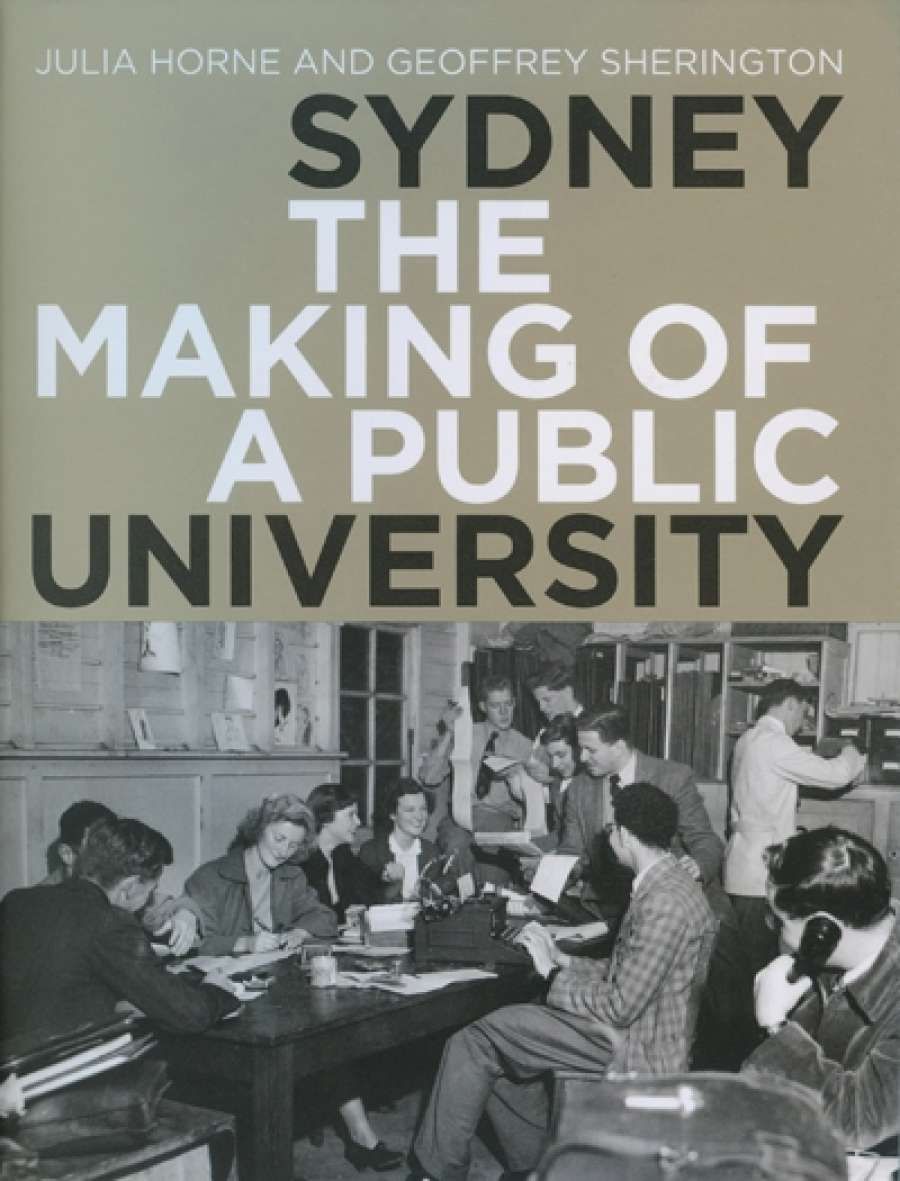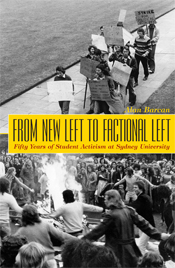
- Free Article: No
- Contents Category: Society
- Review Article: Yes
- Online Only: No
- Custom Highlight Text:
When I became an adjunct professor at the University of Sydney in 2004, I knew nothing of its history, and little of the ideological battles that had taken place there. These two books provide a rich narrative of both, and made me appreciate the privilege I have, even as a marginal player, in belonging to such a significant institution.
- Book 1 Title: Sydney
- Book 1 Subtitle: The Making of a Public University
- Book 1 Biblio: Miegunyah Press, $40 hb, 365 pp, 9780522861211
- Book 2 Title: From New Left to Factional Left
- Book 2 Subtitle: Fifty Years of Student Activism at Sydney University
- Book 2 Biblio: Australian Scholarly Publishing, $44 hb, 254 pp, 9781921509889
- Book 2 Cover Small (400 x 600):

- Book 2 Cover (800 x 1200):

- Non-review Thumbnail:

First, Julia Horne and Geoffrey Sherington’s book. Founded in 1850, Sydney was Australia’s first public university, pre-dating by several years similar institutions in Britain and the United States. The lofty principles of its founders included secular education for all classes of society, serving all faiths but espousing none. The churches complained about the lack of religious instruction, but were mollified by being permitted to attach their own religious residential halls for students.
Funding for Sydney University was provided, as intended, both by the colonial government and rich private benefactors. The latter were mainly city dwellers, the squattocracy being much too sceptical about the value of tertiary education to donate much. Twenty-one donors gave £7050 in the first decade, which translated into millions in trust funds in later years. Among them were free settlers of humble origin, including Thomas Barker, maker of windmills, John Henry Challis, a wool merchant, Thomas Fisher, whose bequest financed the Fisher Library, Thomas Walker, a bootmaker, George Henry Bosch, a merchant, and Samuel McCaughey, a pastoralist. Challis was persuaded to fund ‘The Great Northern Window’ in the Great Hall, which depicts ‘the line of English Sovereigns and their consorts from the Conquests’, no doubt a sight of great comfort to Australian monarchists over the years.
The Commonwealth assumed full responsibility from states for the government part of Australian university funding (about fifty per cent) in 1974, but private bequests continued to be important. One of the most bizarre was from an anonymous American donor who turned up at the vice-chancellor’s office one day in 2009 by appointment. She was toting a black plastic bin liner from which she drew a rolled-up portrait of Marie-Thérèse Walter, one of Picasso’s lovers, painted by him in 1935. She specified that the painting, plus some of her jewellery and bonds, were to be sold and the proceeds used for scientific and medical research.
Driven by the principle mens sana in corpore sano, sports were from the beginning an integral part of student life. Cricket and rugby clubs for men came first, then rowing, tennis, athletics, hockey, and lacrosse. Chipping away at misogyny, women began their own clubs. Although Horne and Sherington don’t say so, these in my view, along with debating, public speaking, and political activism, helped give many women the confidence and status to challenge obstacles to their entry to the professions.
As at all Australian universities, student enrolment at Sydney expanded greatly in the twentieth century. In 1915, state assistance to cover fees was provided to deserving scholars through a few ‘public exhibitions’. After World War II, government study assistance to ex-servicemen and women diversified and broadened the student body. In the 1950s the availability of Commonwealth scholarships, state bursaries, and teachers’ college scholarships encouraged a massive expansion in enrolments. When Gough Whitlam abolished university fees in 1974, women, for the first time, came to outnumber men. Government subsidies shrank when Bob Hawke introduced the Higher Education Contribution Scheme (HECS) in 1989. They contracted further in 1996, when John Howard allowed universities to charge full upfront fees to foreign students.
From New Left to Factional Left approaches the Sydney University story through student politics. Alan Barcan has excellent credentials – a writer with a distaste for jargon, a professional left-wing stirrer who was the editor of Honi Soit, member of the university branch of the Communist Party for six years, and a member of the Newcastle branch of the ALP thereafter.
Barcan traces the evolution of the left at Sydney University since the 1920s, when it was grounded in the Communist Party and the working class, and was regarded by Sydney society with bemused tolerance and condescension. The left-wing views of several clubs were counterbalanced by stalwart Christian clubs, including the Christian Union, Bible League (later the Evangelical Union), Newman Society, Jewish Student Union, and the Student Christian Movement.
Reflecting a rapid increase and diversification in the university population, student radicalism grew after World War II. It paused for reflection when Khrushchev denounced the murderous ways of Stalin in 1956, but, in Monty Pythonesque fashion, it revived and multiplied in the 1960s to include Anarcho-Marxists, Trotskyites, Maoists, Spartacists, Syndicalists, Revolutionary and Democratic Socialists, the Fabian Society, and the Sydney Push.
Barcan discusses the role of the Student Representative Council and Honi Soit as the drivers of student politics. Intramural issues included whether students should have a say in determining curricula, whether end-of-year memory-testing exams should solely determine a student’s performance, and whether the teaching of economics should be confined to dry mathematical modelling or include political, social, and historical interpretations as well.
External causes for protest were not hard to find, including an array of perceived social injustices across Europe. More powerful than these was growing hostility to the war in Vietnam. Queensland University led the way in 1966 in protesting Australian military involvement. Through the activities of student dissidents such as Albert Langer, Monash and La Trobe became storm centres in 1967. Under the leadership of the academic Brian Medlin, Flinders University in Adelaide became a Maoist stronghold. The Sydney campus was not far behind. Inspired by such activists as Meredith Burgmann, Mel Bloom, Keith Windschuttle (according to ASIO a violent revolutionary), Bob Ellis, and Richard Neville, students appealed for funds for the North Vietnamese war effort. SRC president Jim Spigelman exhorted students to emulate rebellions in Paris, Berlin, London, and in American campuses such as Berkeley and Columbia. Honi Soit published an incendiary article leaked from an army manual on ‘How to Recognise a Viet Cong’. Visits to Australia by President Lyndon Baines Johnson and the prime minister of South Vietnam, Air Vice-Marshall Nguyen Cao Ky, aroused more resistance. Sydney activities culminated in the Vietnam moratorium of September 1970. With its love of categories, ASIO listed students as ‘simple protesters, career rebels, children of the Old Left, drug users, beatniks and social deviants, or Christian radicals’.
The movement lost its heat after 1972, when Whitlam promptly withdrew the troops from Vietnam, recognised China, and, for good measure, promised to abolish student fees. Most of the battles that leftist students fought in the 1960s and 1970s they won. Australia has become a multicultural society. Women and Aborigines have more rights. The importance of environmental conservation is undisputed. Such is the degree of moral opprobrium against them that racists have largely gone underground. But our forays into foreign wars such as Iraq and Afghanistan do not arouse the level of public indignation that Vietnam did. It would have made both books more interesting if the authors had speculated about whether left-wing activism might again arise, and with what new targets.


Comments powered by CComment